Schools face a lot of challenges these days. Lack of funding, teacher shortages, curriculum restrictions, and general safety concerns make educating students more difficult than ever. One of the biggest problems doesn’t always get the attention it deserves: chronic absenteeism. Numbers of habitually absent students have skyrocketed in the last few years, and no one seems to know quite what to do about it.
We surveyed nearly 300 teachers to hear about their experiences with chronic absence in the classroom. A whopping 75% of them stated that chronic absence is a major issue in their school or district. They shared story after story of students missing school and falling further and further behind. These teachers also gave us their thoughts on what causes chronic absences, how it affects kids, and the actions we might take to make effective changes. Here’s what we learned.
What is the definition of chronic absenteeism?
Generally, chronic absenteeism is defined as missing 10% or more days of school in a year. For a district with a 180-day year, this works out to 18 days, or around two days per month. It can also refer to students who are habitually significantly tardy, missing substantial parts of the school day.
Most chronically absent students miss far more than two days per month, though. In many cases, it’s more like two to three days a week. In these cases, the detrimental effects become so great that they’re hard to overcome, even with intervention.
How many students are chronically absent?
The numbers for chronic absences vary widely from district to district and state to state. In places like Alaska and Washington, D.C., schools report a chronic absence rate as high as 45%. In areas with lower incidences, like New Jersey and Virginia, the numbers are at about 16%. On average across the country, around one in three students are regularly absent from their classrooms.
What about truant officers?
Contrary to popular opinion, truancy officers don’t just roam the streets looking for kids who skipped school that day. First, it’s important to note that truancy refers to unexcused absences only, while chronic absenteeism includes absence for any reason. So, if a parent reports their child sick each time, or notifies the school that they’ll be taking their child out for several weeks for a long vacation, these absences generally wouldn’t qualify as truant.
Each state has its own truancy laws, which usually require an accumulation of unexcused absences in a specified period of time before the legal system gets involved. This requires a lot of paperwork and documentation by teachers and schools. And many educators note that legal truancy intervention often has little effect.
Take this story from one Kansas teacher: “I had a student who missed 110 days of school in her 7th grade year but was passed on to me in 8th grade. She had been turned in to the truancy officer in 6th grade and in 8th grade. Her younger brother was a 6th grader the year she was in 8th grade. Nothing seemed to work for her or her brother’s attendance issues. Neither child could read or write. … In her 8th grade year that student missed 112 days of school and she was still passed on to 9th grade.”
What effect has COVID-19 had on chronic absence?
In March 2020, COVID-19 forced schools to close their doors and send students home to learn online for the rest of the school year. The uncertainties of the pandemic made 2021-2022 the worst year for chronic absence ever, with numbers nearly doubling from 15% to 28%. This isn’t necessarily surprising. What is concerning is that in 2022-23, chronic absence rates remained much higher than pre-pandemic levels, and the trend continued into 2024.
“Ever since COVID, I’ve noticed more students able to talk their parents into just letting them stay home, or refusing to go,” observes a Virginia teacher who’s been in the classroom for 30+ years. “Parents give in too easily and then report to the school that their student ‘just wouldn’t go and there was nothing I could do.’”
It’s not just anecdotal—the numbers prove it. A study by the American Enterprise Institute found that chronic absence numbers are now 75% higher than they were before COVID hit. (Take a look at state-by-state numbers here.)
How does being chronically absent affect students?
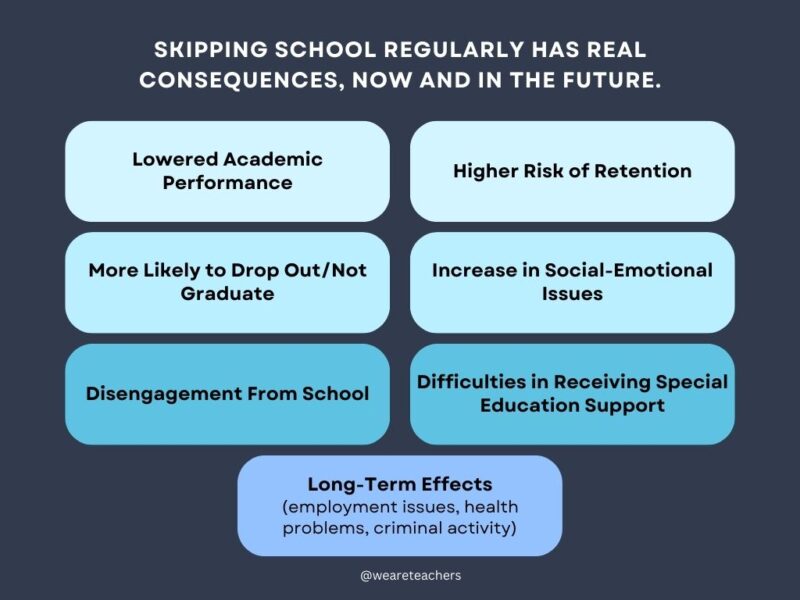
As you might imagine, missing class regularly has an enormous impact on students, and failing grades are just one part of it. Here’s a closer look at the effects of chronic absenteeism.
Lowered Academic Performance
For many educators, the concern is not so much a failing grade as the overall loss of skill accumulation and progression. “Most of the students I see that have chronic absenteeism get so far behind they simply cannot catch up, even with individualized help,” says Alicia H., a high school special ed teacher.
Kate P., a K-2 reading teacher confirms this. “They just fall further and further behind academically. They also tend to get out of the routine and have a harder time getting back into the swing of things in the classroom.”
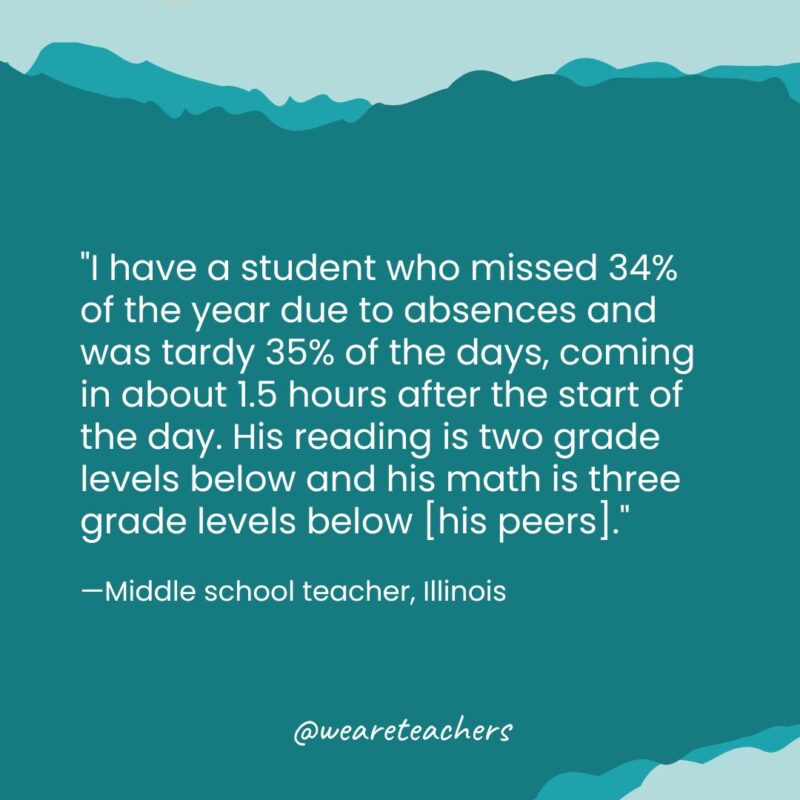
Chronic absence can be especially detrimental in the elementary years, when kids are learning fundamental academic and social skills. “I have a student who last year missed 34% of the year due to absences and was tardy 35% of the days, coming in about 1.5 hours after the start of the day,” an Illinois middle school teacher relates. “He is almost never sick—he just doesn’t want to come to school and his mom lets him stay home. His reading is two grade levels below and his math is three grade levels below [his peers].”
Higher Risk of Retention
Not surprisingly, this academic impact means students are at a much higher risk of being held back. One teacher shared the story of a family with four children, all chronically absent. Two of these children had to be retained at least once due to the issue.
More Likely To Drop Out or Be Unable To Graduate
When students keep falling further and further behind, school becomes such a chore that they simply give up. These kids are likely to drop out of high school before finishing; students with just one year of chronic absenteeism are seven times more likely to drop out before graduation.
Even if a student can keep up with their work, school attendance policies can mean they’re still not eligible to graduate. “I had a student who came two days at the beginning of the semester and four days at the end of the semester and wanted to complete all her work in the four days,” says one New York teacher. “It was impossible for her to make up all the work. She was a senior and she missed out on so many of the fun experiences because she was absent. She then cried to me about how she might not be able to graduate.”
Increase in Social-Emotional Issues
Missing school is about more than falling behind in academics: It can also have a big impact on social-emotional issues. That same New York teacher explains, “When they are absent, they miss out on social activities, talking to friends, listening to conversations within class that cannot always be made up. They don’t ever learn perseverance and how to complete things even when you don’t really feel like it. They then do the same thing at a job and don’t understand why the employer is mad and fires them.”
Virginia 7th grade teacher Crystal J. gave this example: “We had a student that had chronic absenteeism,” she says. “Fortunately, he was smart enough that he could keep up with his work and grades. The downside was that he had limited social skills and high anxiety. Had he been in school, he would have been more comfortable with other students and his teachers. This would have helped his anxiety and social skills.”
“I had a student that was suddenly absent for weeks before coming in for a day or two,” recalls a New York middle school teacher. “The grandmother had passed away and the single mom was struggling with her grief and couldn’t get the student (who had a disability) up and on the bus. When the student was in school, we observed an increase in behavior, meltdowns, and a regression in communication skills and academics.”
Disengagement From School
Extended absences make it hard for students to connect with their peers and teachers. As a consequence, they lose interest in school, which feeds more chronic absence behavior.
“A student was out for four weeks, and in that time, a new student enrolled in our room, we adjusted our daily schedule, and moved furniture around the classroom,” preschool teacher K. Hylden told us. “This student was very high academically, and he enjoyed talking with friends and participating in class.
“Upon his return, the changes were overwhelming to him. He became withdrawn, his friends had joined new social circles, and the room felt unfamiliar to him. It took a couple weeks for his walls to come back down, and although his academics remained high, his social-emotional world was rocked by the changes. I met with his parents and discussed that although he could still recite his letters and rote count, missing out on so much classroom time and change dysregulated his core, and he wasn’t enjoying school anymore. With time, he did readjust, and his absences decreased.”
Difficulties in Receiving Special Education Support
Schools today often have robust special education programs, providing accommodations and adaptations for students for a variety of physical and academic differences. But in order to be assessed for these programs, kids have to be in school consistently. Otherwise, it’s hard to determine if their issues are caused by a need for special educations services, or are just the result of missing too much instruction. Multiple teachers in our survey shared stories of kids who desperately needed special education intervention but didn’t qualify because of chronic absenteeism.
Long-Term Effects
In a press release on the topic in September 2023, the White House noted that, “irregular attendance can be a predictor of high school drop-out, which has been linked to poor labor market prospects, diminished health, and increased involvement in the criminal justice system. Students who are chronically absent are at higher risk for these adverse outcomes.” In other words, chronic absence can affect students long after their school years are over.
What causes chronic absenteeism?
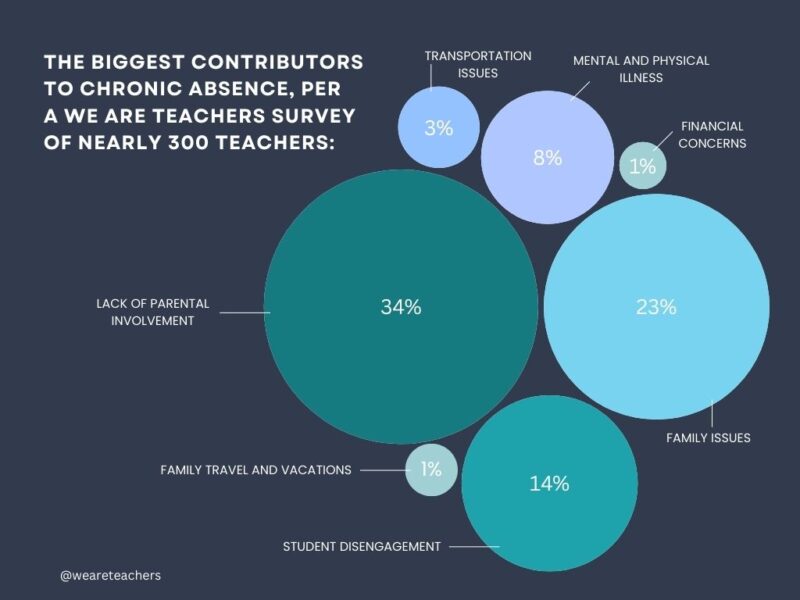
Our survey of almost 300 educators showed that parents and families have a major impact on whether students are absent regularly. Nearly 60% of respondents said that complex home lives and lack of parental involvement were the biggest causes.
Others pinpointed a lack of interest on the part of students, health issues (usually related to mental health), and transportation challenges. Many, especially in wealthier districts, complained that parents regularly pulled their kids out of school for travel and family vacations mid-year. Educators worry that a lack of consequences and overall feeling that school just isn’t that important are continuing to fuel the fire.
Lack of Parental Involvement
More than a third of those we surveyed specifically called out parents when it comes to chronic absences. Over and over again, they shared stories of parents who won’t or can’t help their child make it to school.
“Students who are chronically absent typically do not have parents that are very involved in their education,” a New Mexico 2nd grade teacher notes. “These are the parents that are difficult to get ahold of and do not come to school events or parent-teacher conferences.”
Some parents just aren’t willing (or able) to make their children cooperate. According to an Indiana teacher: “Students in the upper grades challenge parents about attending school, and I feel that some parents would rather call them in sick than fight to get them to school.”
Family Issues
In many situations, educators note that chronically absent students are often those who are responsible for getting themselves up and off to school in the morning. This is usually because their parents have already left for work, though sometimes the parents simply choose not to get up themselves. “I had a student—very very bright—be tardy over 40 times due to mom not getting up on time. She missed so much and it made her feel rushed in the morning. Just wasting her potential,” laments an Alabama 1st grade teacher.
Other families need their child to stay home to watch younger siblings, or struggle financially so older kids skip school to work instead. Some are unhoused, living in shelters or even on the streets. Parents may struggle with mental or physical health problems, making home life chaotic and unregulated. School falls by the wayside as these families just struggle to get by.
Student Disengagement

For some kids, the idea of getting an education and graduating simply isn’t enough to make them want to go to school. They might argue that their required classes aren’t really preparing them for “real life,” or feel it just doesn’t matter anyway. “Engagement is a huge motivator,” explains a Kansas reading teacher and librarian. “We encourage all our students to get involved with activities, athletics, and clubs. I have many students say that their music classes gave them a reason to come to school or that staying eligible to play sports made them show up and get their work done.”
Health Issues
Health concerns, often related to mental health, are another big cause of chronic absenteeism. An Iowa teacher shares: “I had a student who had such high anxiety that each day, his objective was to get home. He, as a 3rd grader, would cry each morning and then keep telling me he had a stomachache. I think he did work himself up into having a stomachache. But he was used to being appeased, and his efforts made his mom feel guilty and sad for him, so she sometimes gave in to his wishes.”
Nearly 14% of school-age children are diagnosed with anxiety and/or depression disorders, and the number seems to increase every year. This is likely to become an even bigger cause of chronic absence unless we take action to address the issue.
Transportation Challenges
A small but significant portion of students face challenges making their way to school every day. Sometimes it’s because they get up late and miss the bus. Other times, they live out of the range of school or public transportation. These kids rely on parents to make arrangements to get them to school, and their parents don’t always follow through.
“I had a 4th grade boy who missed about 2 days every week (sometimes more) because the family lived an hour away from our school,” a California elementary teacher told us. “His mother worked at a local hospital and that is why she put him at our school (which is also highly ranked). However, on the days she didn’t work, they wouldn’t drive to school and he would be absent.”
Vacations/Travel During the Academic Year
“I was teaching 3rd grade and had a student whose parents took him out of school for vacations constantly,” says Lori M., who teaches in Michigan. “The student would be gone for 2-3 weeks at a time. There was no way I could provide work for that amount of time, so I would require the student to write in a daily journal. That was fine, but missing the daily interaction and conversation that whole-group discussion provides was detrimental to his learning, as testing showed.”
Vacations don’t have to be frequent to cause problems, as a story from a California teacher shows. “I often think about a little first grader last year who took a whole month off to visit family in China. When she came back to school, she was very emotional and got in a lot of fights with people because she had a really hard time getting back into the school culture and expectations. She struggled academically whereas she was usually one of the higher performing students … that one month away impacted her for the rest of the year.”
Lack of Repercussions
Although many would point out that a lack of education is consequence enough, students and even many parents don’t see it that way. A Massachusetts teacher states, “We have one student who has had over 100 absences each year. Student keeps moving on. He is performing at a 1st grade level in 5th grade. Family even went to court but nothing came of it.”
Devaluation of Education
In a profession that feels more disrespected all the time, teachers have seen the impacts that an apathetic attitude can cause. “Parents create generations of kids who are chronically absent because parents don’t value education,” opines the Kansas ELA teacher. “In my school there are families of students who are chronically absent. When parents are contacted, one of two responses are given: That’s the school’s problem so you deal with it because I can’t do anything with my kid OR these are my children to raise how I want so why do you care if my kids are in school?”
The problem is often cultural or related to socioeconomic status. “We are a high poverty district and parents don’t see any value in education. There is generational poverty and students have no desire to better themselves and break the cycle,” observes Melissa Adams, who teaches 6th grade science in Ohio.
How can schools reduce chronic absenteeism?
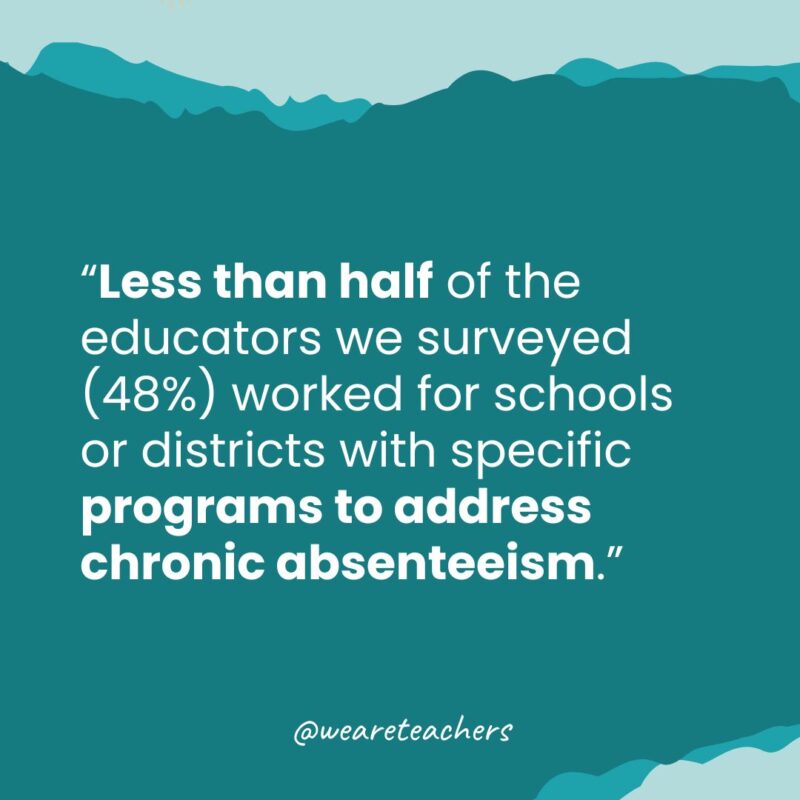
Of the teachers we surveyed, less than half worked for schools or districts that had special programs in place to address chronic absence. Many of those programs simply rely on enforcing truancy laws, though some take a more unique approach. These are the ideas that seem to work best, with real-life success stories to back them up.
Catch it early and identify the cause.
Chronic absence isn’t always a choice. Sometimes circumstances are outside of a family’s control, and they desperately need help. Parents may feel they can’t control their child and don’t know who to turn to. It might turn out there are health issues that need to be addressed, transportation issues that can be solved, or services that can help families in need. Take time to learn more about each chronically absent student and their unique situation.
- Success Story: “There was a student I worked with that was held back in kindergarten and repeated it again. He was very smart but lacked structure and had behavioral issues due to adjusting to school again after long periods of absence. We reached out to the family, reached out to the bus company, etc. The biggest impact was figuring out some causes. He had access to his mom’s phone and would turn off alarms. They would miss the bus because the stop was down the street. Collaborating with mom and the bus company helped move the bus stop and increased his attendance.” —Connecticut speech language pathologist
Develop strong relationships with families and communities.
Over and over, teachers in our survey stressed the importance of making connections and holding parents accountable for their child’s attendance. Whether you’re providing support, explaining the importance of education, or figuring out alternative education options, open lines of communication are key to making change happen.
- Success Story: “We had a student in 6th grade who refused to get out of bed in the morning. Her anxiety kept her home. Mom wanted to avoid a fight, so she would let her stay home. We reached out continuously, kept in contact with Mom and the student, but the student very nearly failed 6th grade. We got our in-house counseling/therapy service involved and they helped the student and her mom find appropriate treatment and coping skills for the anxiety, a ‘safe’ place here at school to go when she was feeling overwhelmed, and helped build her confidence. She is here almost every day now—completing her 8th grade year.”
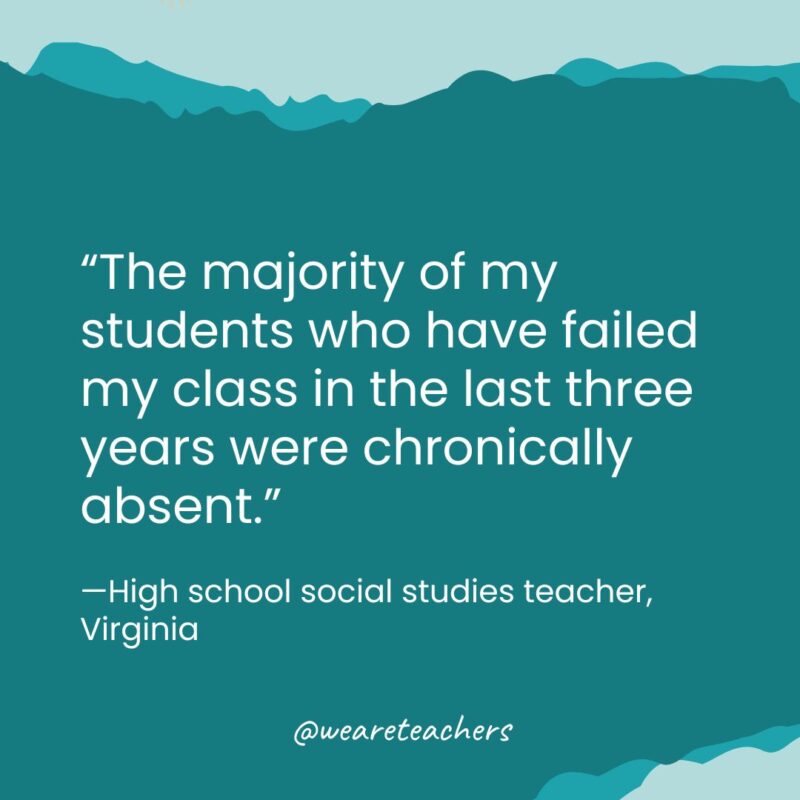
Remove barriers.
What’s stopping a child from coming to school? Are they afraid of being bullied, or lonely and isolated without a social group? When they miss the bus, do they not have any other way to get to school? Do they lack access to clean clothing or toiletries? Address problems by providing tailored solutions, so school can become a priority again.
- Success Story: “Our school had a one year grant that provided a social worker to meet with our at-risk students and confer with families. She would go pick up the students from the home if needed. She made home visits to help families get needed support.” —Ohio 7th grade science teacher
Make school a place students want to be.
Does your school actively welcome all students and create a sense of community? When students feel wanted and seen every time they walk through the door (and missed when they don’t), they’re a lot more likely to attend regularly. Make changes to make your school safe, welcoming, and enjoyable for all, and chronic absences are likely to drop.
- Success Story: “I have a student that was chronically absent last year that was lackadaisical about after-school activities. He is now back in my freshman Algebra class again. He is also in our band. Our band is a top-notch organization and our director will not tolerate chronic absenteeism. They go on trips to other states—next summer they are going to Washington, DC. If they have chronic absenteeism, they will not be allowed to go on the trips. This student never misses class this year. I don’t know if it’s because he is having to repeat the class or because he is our lead cymbals player and others are looking to him for leadership. But whatever it is, it works.” —Julia Riggs, high school special ed math lab teacher)
Provide accommodations and support.
Be creative when looking for solutions. Alternative or online schools can help accommodate variable schedules. When students fall far behind, ensure they have access to tutoring and academic support to help get them back on track. Look for ways to help lonely or isolated students find friends among their peers—the chance to see those friends each day can help them stay in school.
- Success Story: “A student was chronically absent and falling behind academically fast and had no friends. We set them up in a peer-to-peer program where they became friends quickly. The student began to show up every day and quickly caught back up academically.” —Michigan Behavior Intervention K-8
Offer incentives.
Although some people balk at the idea of “bribing” kids to get them to come to school, incentive programs can be very effective. If your school’s absentee rate is high, a program that rewards students for showing up on time each day can help turn things around.
- Success Story: “We have a Strive for Five program where the kids are encouraged to come to school five days in a row. If a student is in school 95% of the time for the quarter, they get to go on an attendance field trip. [More] students have been coming to school.” —Michigan Behavior Intervention K-8
Devote more resources to the problem.
Teachers have enough on their plates already, so don’t expect them to take on the heavy lifting if your school is facing a lot of chronic absences. Instead, consider creating a position specifically to address the problem, like a school resource officer or attendance monitor.
- Success Story: “Our school has an attendance monitor position. … That person follows up on students who are missing too many days of school or who have a pattern of missing school. They make contact with parents to see what we can do to support their child being in school. They call and even make home visits if needed. … The attendance monitor will follow up, offer whatever assistance we may be able to provide, like getting the student bus transportation, or talking with the family about any challenges they are facing at the moment. The attendance monitor will also politely remind them about the law in regard to having kids be in school … and that a warrant could be issued for their arrest.” —Iowa 3rd grade teacher
Enforce consequences.
So many teachers in our survey noted that there didn’t seem to be any real consequences for their chronically absent students. They still continue to be passed from grade to grade, even though their skills are lacking. Truancy courts are so backed up that referrals are ineffective. But when students and parents routinely faced consequences for chronic absence, many educators reported real improvement.
- Success Story: “We have a tribunal system. The students and parents are required to meet with a judge. In the case of our campus, the judge is a retired school principal. On other campuses, it is an actual retired judge. These tribunals give the students options and ways to not miss school and be successful. Their accomplishments are celebrated and if they are not making progress, other steps are taken. This is a way to keep the students out of the truancy courts. it has helped many of our students actually make progress towards coming to school and being successful.” —Marian I., Texas ELAR grades 9-12
Use the system.
Ultimately, you just have to get the legal system involved. It doesn’t always work, but for some families, it makes a difference.
- Success Story: “I had a student 3 years ago who was chronically absent. When he did come to school, he was often 1-2 hours late. He would often sleep at school. His mother did not regulate his bed time, and she would often sleep late. She didn’t see school as a priority. I called her and explained how important it is that he be at school on time. The counselor called, and the principal called. They said the same thing. The nurse even called. Nothing worked. They went to court, and she was scared by the amount of money she would have to pay if he was not at school. So, she began to bring him.” —Texas 3rd grade teacher
Where do we go from here?

“This is the biggest and most challenging obstacle to student success I am seeing right now,” worries Cathy G., a high school English teacher in Indiana. A Minnesota teacher agrees: “We have to start asking the questions of what is happening and why. … We are failing our kids in our classrooms.”
It’s time to bring chronic absenteeism to the forefront of education discussions, and provide schools with the resources they need to fight it. Addressing chronic absenteeism takes support from schools, families, and communities. It requires effort, resources, and people willing to step in and help. We can’t solve the problem for every student and every family. But we can certainly do better, and the time to start is now.

